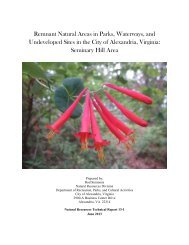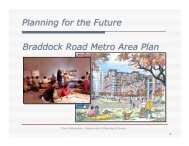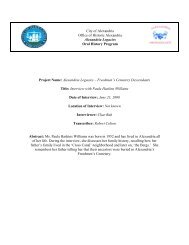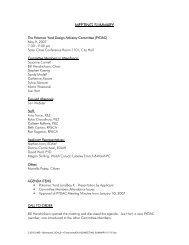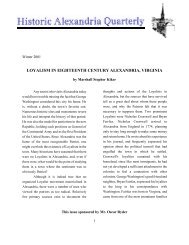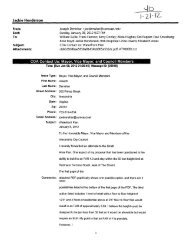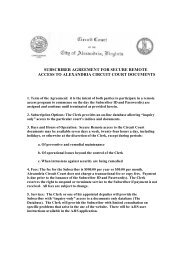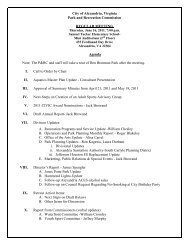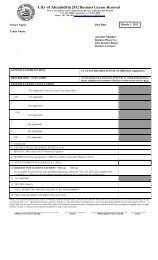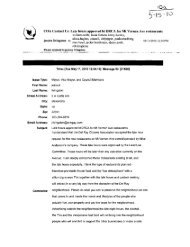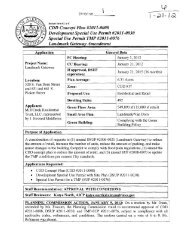Case Studies - Affordable Housing Regulatory ... - City of Alexandria
Case Studies - Affordable Housing Regulatory ... - City of Alexandria
Case Studies - Affordable Housing Regulatory ... - City of Alexandria
You also want an ePaper? Increase the reach of your titles
YUMPU automatically turns print PDFs into web optimized ePapers that Google loves.
housing. And, in the process, a municipality can help to address the broader quality <strong>of</strong> life issues that affect its<br />
citizens and the citizens across the region. The examples below show how two <strong>of</strong> the four cities created significant<br />
affordable housing using inclusionary zoning. Details <strong>of</strong> the programs may differ, but the concept is the same.<br />
4a. Boulder, Colorado<br />
Source:<br />
http://www.bpichicago.org/documents/Denver_Report.pdf<br />
Overview<br />
In 2000, in response to rapidly rising housing costs and the ineffectiveness <strong>of</strong> a voluntary inclusionary housing<br />
program, the <strong>City</strong> <strong>of</strong> Boulder passed a mandatory inclusionary housing ordinance. The new program requires 20%<br />
<strong>of</strong> housing in new developments to be priced affordably for low‐income households (households earning less than<br />
80% <strong>of</strong> the area median income). The comprehensive mandatory ordinance covers all residential developments<br />
regardless <strong>of</strong> size (with the exception <strong>of</strong> developments <strong>of</strong> a single lot with one owner and total floor area <strong>of</strong> less<br />
than 1,600 feet).<br />
How does it work?<br />
If the development has four or fewer units, the developer must create one affordable unit on‐site, one affordable<br />
unit <strong>of</strong>f‐site, dedicate land for one affordable unit, or pay a fee <strong>of</strong> roughly $18,000 to Boulder’s <strong>Affordable</strong> <strong>Housing</strong><br />
Trust Fund. The only cost <strong>of</strong>fset provided to the developer is a waiver <strong>of</strong> development excise taxes. However, for<br />
developments that provide more than 20% affordable units, the developer can also receive subsidy funds for land<br />
use review and building permit fees.<br />
Results<br />
Since 2000, the <strong>City</strong> <strong>of</strong> Boulder constructed 380 affordable homes, including condominiums, townhomes, and<br />
single‐family homes. While market‐rate units in the developments continued to sell for between $390,000 and<br />
$430,000, the affordable units were priced between $112,000 and $185,000. Ninety‐eight percent <strong>of</strong> people who<br />
moved into the affordable units already lived or worked in Boulder, and they included teachers, nurses and other<br />
service sector workers. The <strong>City</strong> collected $1.5 million in fee‐in‐lieu payments from roughly 50 developments.<br />
Payments are deposited in an affordable housing fund, which has subsidized the creation <strong>of</strong> about 80 affordable<br />
units each year.<br />
Challenges<br />
The current inclusionary zoning ordinance has both a direct and an indirect effect on the market price <strong>of</strong> housing in<br />
Boulder. The direct effect is that developers must make up the incremental cost <strong>of</strong> constructing permanently<br />
affordable dwellings. Some <strong>of</strong> these costs are passed on to Boulder‘s homebuyers. The indirect effect is that house<br />
prices for all housing consumers increase as the <strong>City</strong> takes existing dwellings out <strong>of</strong> the housing stock and<br />
dedicates them to permanent affordable units. Furthermore, the existing program for permanent affordable<br />
owner‐occupied housing accelerates the rate <strong>of</strong> depreciation in the stock <strong>of</strong> owner‐occupied housing because it<br />
does not allow homeowners to earn a return on their maintenance and repair expenditures.<br />
Applicability to <strong>Alexandria</strong><br />
The mandatory zoning approach to affordable housing has proven to be a very effective means <strong>of</strong> increasing the<br />
number affordable housing units in many localities and could be a very effective tool to produce more affordable<br />
housing in the <strong>City</strong> <strong>of</strong> <strong>Alexandria</strong>. However, this tool would need state enabling legislation to be implemented.<br />
<strong>Affordable</strong> <strong>Housing</strong> <strong>Regulatory</strong> Tools <strong>Case</strong> <strong>Studies</strong> Compiled by the <strong>Alexandria</strong> Office <strong>of</strong> <strong>Housing</strong>, December 2010<br />
5



